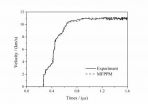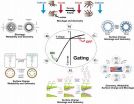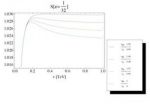(Press-News.org) The oil and gas extraction method known as hydraulic fracturing, or fracking, could potentially contribute more pollutants to groundwater than past research has suggested, according to a new study in ACS' journal Environmental Science & Technology. Scientists are reporting that when spilled or deliberately applied to land, waste fluids from fracking are likely picking up tiny particles in the soil that attract heavy metals and other chemicals with possible health implications for people and animals.
Tammo S. Steenhuis and colleagues note that fracking, which involves injecting huge volumes of fluids underground to release gas and oil, has led to an energy boom in the U.S. But it has also ignited controversy for many reasons. One in particular involves flowback, which refers to fluids that surge back out of the fracked wells during the process. It contains water, lubricants, solvents and other substances from the original fracking fluid or extracted from the shale formation. High-profile spills and in some places, legal application of these liquids to land, have raised alarms. Research has linked fracking to groundwater contamination that could have major health effects. But another factor that no one has really addressed could play a role: colloids. These tiny pieces of minerals, clay and other particles are a concern because they attract heavy metals and other environmental toxins, and have been linked to groundwater contamination. Steenhuis' team set out to take a closer look.
To simulate what would happen to colloids in soil after a fracking spill, the researchers flushed flowback fluids through sand with a known amount of colloids. They found that the fluids dislodged about a third of the colloids, far more than deionized water alone. When they increased the flow rate, the fluids picked up an additional 36 percent. "This indicates that infiltration of flowback fluid could turn soils into an additional source of groundwater contaminants such as heavy metals, radionuclides and microbial pathogens," the scientists conclude. More research with real soils is planned.
INFORMATION:
The authors acknowledge funding from HATCH funding of the U.S. Department of Agriculture, the National Science Foundation, the Chinese Scholarship Council, and the National Natural Science Foundation of China.
The American Chemical Society is a nonprofit organization chartered by the U.S. Congress. With more than 161,000 members, ACS is the world's largest scientific society and a global leader in providing access to chemistry-related research through its multiple databases, peer-reviewed journals and scientific conferences. Its main offices are in Washington, D.C., and Columbus, Ohio.
To automatically receive news releases from the American Chemical Society, contact newsroom@acs.org.
Follow us: Twitter Facebook
Another concern arises over groundwater contamination from fracking accidents
2014-06-25
ELSE PRESS RELEASES FROM THIS DATE:
Fast, portable device for 'on-the-go,' laboratory-quality cocaine testing
2014-06-25
Testing for cocaine and other drugs usually involves two steps: a quick on-site prescreen, and then a more accurate confirmatory test at a distant laboratory. This process can take days or weeks — but that's too long in many cases where public safety is at risk. Now, researchers report development of a backpack-sized device that can perform highly accurate and sensitive tests anywhere within 15 minutes. The study appears in ACS' journal Analytical Chemistry.
Aaron Wheeler and colleagues explain that the current two-stage system of testing urine for drugs of abuse is expensive ...
Nanoscale velcro used for molecule transport
2014-06-25
Biological membranes are like a guarded border. They separate the cell from the environment and at the same time control the import and export of molecules. The nuclear membrane can be crossed via many tiny pores. Scientists at the Biozentrum and the Swiss Nanoscience Institute at the University of Basel, together with an international team of researchers, have discovered that proteins found within the nuclear pore function similar to a velcro. In Nature Nanotechnology, they report how these proteins can be used for controlled and selective transport of particles.
There ...
Invisibility cloak for immune cells
2014-06-25
This news release is available in German. The human immune system is very complex. A large number of different cells with various functions ensure that invading microorganisms such as viruses or bacteria can quickly be rendered innocuous and the entire organism stays healthy.
The immune system also includes natural killer cells (NK cells), which recognise and eliminate tumour or virus-infected cells. NK cells therefore combat the body's own stressed cells to prevent them from becoming a potential hazard. However, this bears its risks. Other immune cells, the specific ...
The breakthrough of hypervelocity launch performed on 3-stage light gas gun in CAEP
2014-06-25
In the past 20 years, the Laboratory for Shock Wave and Detonation Physics Research in Institute of Fluid Physics (IFP), China Academy of Engineering Physics (CAEP) has conducted the research in hypervelocity launch technology. The State Key Laboratory of Advanced Technology for Materials Synthesis and Processing of Wuhan University of Technology participated in the research as a cooperator, and took charge of the flier processing. In this project, significant progresses have been made in optimization of the physical design, material processing and experimental measurement ...
Smart gating nanochannels for confined water developed by CAS researchers
2014-06-25
Confined water exists widely and plays important roles in natural environments, particularly inside biological nanochannels. Professor Lei Jiang and his group from State Key Laboratory of Organic Solids, Institute of Chemistry, Chinese Academy of Sciences, set out to study this unified bionic frontier. After several years of innovative research, they developed a series of biomimetic nanochannels, delivered a strategy for the design and construction of smart nanochannels and applied the nanochannels in energy conversion systems. The author thought the inner surface property ...
Recent progress in whole-lifecycle software architecture modeling
2014-06-25
The gradually increasing complexity of user requirements and runtime environments of software demands software to be of more capabilities and thus become more complex than ever. In the past several decades, there was a trend that the scale of software has been increasing continuously. Nowadays, there are tens or even hundreds of million lines of code in a large scale software system. For example, the Windows operating system scales from 15 million lines of code in 1995 to 60 million lines of code in 2007; in 2011, the scale of software in BMW 7 Series reaches 200 million ...
Street football boosts fitness and health in socially deprived men
2014-06-25
Research carried out by the Copenhagen Centre for Team Sport and Health in Denmark shows that street football (soccer) improves fitness and multiple health markers in homeless men. After only 12 weeks, the participants had better postural balance and higher muscle mass and bone mineralization, along with lower fat percentage and LDL cholesterol and higher aerobic fitness and exercise capacity.
Sixteen original scientific articles about the health effects of football were published on June 19 in the Scandinavian Journal of Medicine & Science in Sports. One of these articles ...
Evidence of the big fix?
2014-06-25
There are many open questions that the Standard Model cannot answer. One of them is the smallness of the Higgs expectation value vh compared with the Planck scale. In their latest work, Dr Yuta Hamada, Dr Hikaru Kawai and Dr Kiyoharu Kawana at Kyoto University, consider the radiation S of the universe at the late stage as a function of vh, and they show that S reaches its maximum around the observed value vh = 246 GeV.
"If we demand that S should be maximized, this conclusion can be the explanation to the above question. The main contribution to S comes from the decay ...
Master regulator of key cancer gene found, offers new drug target
2014-06-25
MINNEAPOLIS/ST. PAUL (June 23, 2014) – A key cancer-causing gene, responsible for up to 20 percent of cancers, may have a weak spot in its armor, according to new research from the Masonic Cancer Center, University of Minnesota.
The partnership of MYC, a gene long linked to cancer, and a non-coding RNA, PVT1, could be the key to understanding how MYC fuels cancer cells. The research is published in the latest issue of the journal Nature.
"We knew MYC amplifications cause cancer. But we also know that MYC does not amplify alone. It often pairs with adjacent chromosomal ...
Brewing yeasts reveal secrets of chromosomal warfare and dysfunction
2014-06-25
SEATTLE –Using two yeasts that have been used to brew tea and beer for centuries, researchers at Fred Hutchinson Cancer Research Center have revealed how reproductive barriers might rapidly arise to create species boundaries. Schizosaccharomyces pombe has been used to brew beer in Africa, whereas its close relative S. kombucha is a component of kombucha tea commonly found in health-food stores.
A team of researchers led by Dr. Sarah Zanders of the Basic Sciences Division at Fred Hutch, has uncovered why hybrids between these yeasts (commonly referred to as fission yeasts) ...



